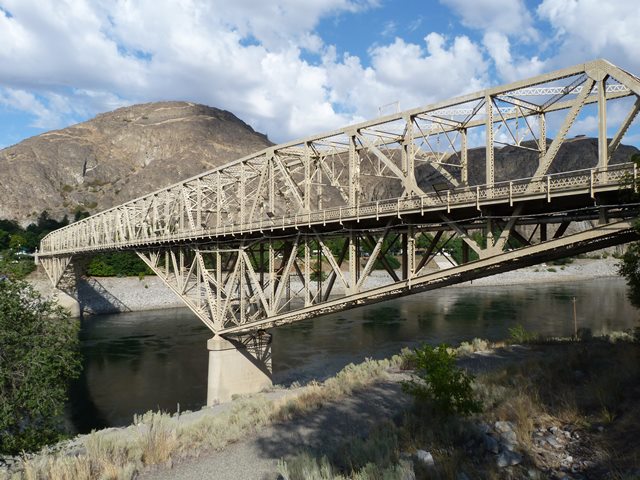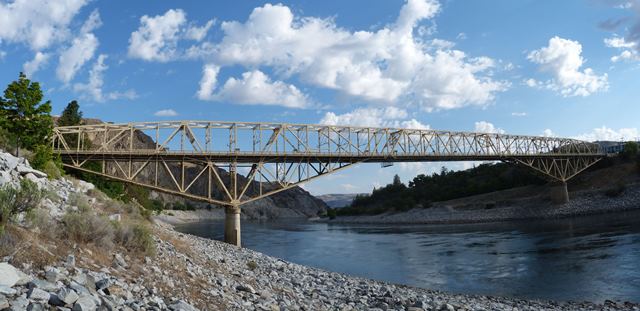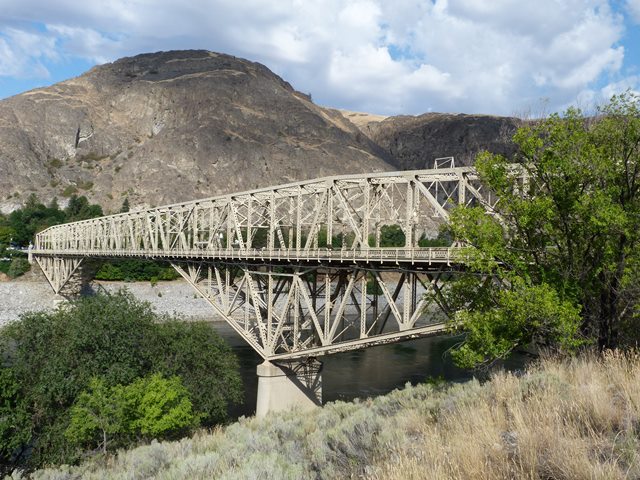We Recommend:
Bach Steel - Experts at historic truss bridge restoration.
Grand Coulee Bridge

Primary Photographer(s): Nathan Holth
Bridge Documented: August 21, 2014
Coulee Dam: Douglas County, Washington and Okanogan County, Washington: United States
Metal Cantilever 22 Panel Rivet-Connected Warren Through Truss, Fixed and Approach Spans: Concrete T-Beam, Fixed
1935 By Builder/Contractor: J. H. Pomeroy of San Francisco, California and Engineer/Design: Washington Department of Highways
Not Available or Not Applicable
550.0 Feet (167.6 Meters)
1,089.0 Feet (331.9 Meters)
20.3 Feet (6.19 Meters)
3 Main Span(s) and 4 Approach Span(s)
000000JJ0000000

View Information About HSR Ratings
Bridge Documentation
View Archived National Bridge Inventory Report - Has Additional Details and Evaluation
View Historic American Engineering Record (HAER) Documentation For This Bridge
HAER Data Pages, PDF
HAER Documentation, Washington Cantilever Bridges - Data Pages - Drawings
View Historical Article About This Bridge
View Historic Structure Reports For This Bridge
Taking into account age, design, and breathtaking location, this is one of the most impressive historic bridges in the state.
In overall truss shape, this cantilever truss bridge takes on the shape that is somewhat unique to Washington State and dissimilar to cantilever truss bridges in other states. This form essentially takes the pointy towers that most cantilever truss bridges have rising above the roadway at the piers and flips them upside down and places them under the deck, so that the bridge comes to a point at the pier, while the top chord remains more or less flat, aside from a slight slope in the ends of the anchor arms. The result is a truss that likely would have been received as more visually pleasing, but, like a deck truss, would require a greater clearance below the roadway to accommodate the extra truss that was located below the deck. This extra space would only be needed around the piers however; full under-deck clearance is achieved at the center of the span with all the truss above the deck at that point.
Washington State has a number of surviving cantilever truss bridges which date to after the 1930s and have this distinctive truss arrangement. Since the Grand Coulee Bridge date to 1935 however, it is an early and thus particularly noteworthy example of this design in the state.
The bridge has a suspended span that is visually concealed to some extent by the use of a top chord that does not change its angle at the suspended span, and suspended span truss members that are similar in size and design to those of the cantilever and anchor arms. The bridge does however have an extensive system of pins and shear locks that connect the cantilever arms to the suspended span.
This is not a small bridge, yet it often feels like it is tiny as it sits in the shadow of rocky cliffs and the massive Grand Coulee Dam both of which completely dwarf the bridge.
The bridge remains in good condition and the historic integrity is also very good with no major alterations noted. The bridge includes concrete t-beam approach spans at the west end. At both ends of the bridge, concrete railings provide an approach to the truss spans. What appears to be the original ornamental lighting remains on both these approaches and mounted on the trusses.
It was noted that trucks use the bridge and have trouble negotiating the sharp curve onto the bridge from the west approach, and end up taking up both lanes as they enter the bridge, forcing oncoming traffic to stop.

![]()
Photo Galleries and Videos: Grand Coulee Bridge
Structure Overview
Original / Full Size PhotosA collection of overview photos that show the bridge as a whole and general areas of the bridge. This gallery offers photos in the highest available resolution and file size in a touch-friendly popup viewer.
Alternatively, Browse Without Using Viewer
![]()
Structure Details
Original / Full Size PhotosA collection of detail photos that document the parts, construction, and condition of the bridge. This gallery offers photos in the highest available resolution and file size in a touch-friendly popup viewer.
Alternatively, Browse Without Using Viewer
![]()
Structure Overview
Mobile Optimized PhotosA collection of overview photos that show the bridge as a whole and general areas of the bridge. This gallery features data-friendly, fast-loading photos in a touch-friendly popup viewer.
Alternatively, Browse Without Using Viewer
![]()
Structure Details
Mobile Optimized PhotosA collection of detail photos that document the parts, construction, and condition of the bridge. This gallery features data-friendly, fast-loading photos in a touch-friendly popup viewer.
Alternatively, Browse Without Using Viewer
![]()
CarCam: Eastbound Crossing
Full Motion VideoNote: The downloadable high quality version of this video (available on the video page) is well worth the download since it offers excellent 1080 HD detail and is vastly more impressive than the compressed streaming video. Streaming video of the bridge. Also includes a higher quality downloadable video for greater clarity or offline viewing.
![]()
CarCam: Westbound Crossing
Full Motion VideoNote: The downloadable high quality version of this video (available on the video page) is well worth the download since it offers excellent 1080 HD detail and is vastly more impressive than the compressed streaming video. Streaming video of the bridge. Also includes a higher quality downloadable video for greater clarity or offline viewing.
![]()
Maps and Links: Grand Coulee Bridge
Coordinates (Latitude, Longitude):
Search For Additional Bridge Listings:
Bridgehunter.com: View listed bridges within 0.5 miles (0.8 kilometers) of this bridge.
Bridgehunter.com: View listed bridges within 10 miles (16 kilometers) of this bridge.
Additional Maps:
Google Streetview (If Available)
GeoHack (Additional Links and Coordinates)
Apple Maps (Via DuckDuckGo Search)
Apple Maps (Apple devices only)
Android: Open Location In Your Map or GPS App
Flickr Gallery (Find Nearby Photos)
Wikimedia Commons (Find Nearby Photos)
Directions Via Sygic For Android
Directions Via Sygic For iOS and Android Dolphin Browser
USGS National Map (United States Only)
Historical USGS Topo Maps (United States Only)
Historic Aerials (United States Only)
CalTopo Maps (United States Only)













